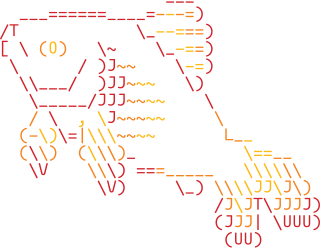
ASCII art is a graphic design technique that uses computers for presentation and consists of pictures pieced together from the 95 printable characters defined by the ASCII Standard from 1963 and ASCII compliant character sets with proprietary extended characters. The term is also loosely used to refer to text-based visual art in general. ASCII art can be created with any text editor, and is often used with free-form languages. Most examples of ASCII art require a fixed-width font such as Courier for presentation.

A bulletin board system (BBS), also called a computer bulletin board service (CBBS), is a computer server running software that allows users to connect to the system using a terminal program. Once logged in, the user performs functions such as uploading and downloading software and data, reading news and bulletins, and exchanging messages with other users through public message boards and sometimes via direct chatting. In the early 1980s, message networks such as FidoNet were developed to provide services such as NetMail, which is similar to internet-based email.

Software cracking is an act of removing copy protection from a software. Copy protection can be removed by applying a specific crack. A crack can mean any tool that enables breaking software protection, a stolen product key, or guessed password. Cracking software generally involves circumventing licensing and usage restrictions on commercial software by illegal methods. These methods can include modifying code directly through disassembling and bit editing, sharing stolen product keys, or developing software to generate activation keys. Examples of cracks are: applying a patch or by creating reverse-engineered serial number generators known as keygens, thus bypassing software registration and payments or converting a trial/demo version of the software into fully-functioning software without paying for it. Software cracking contributes to the rise of online piracy where pirated software is distributed to end-users through filesharing sites like BitTorrent, One click hosting (OCH), or via Usenet downloads, or by downloading bundles of the original software with cracks or keygens.
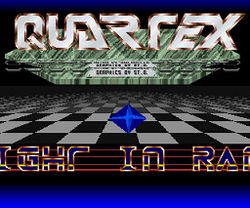
A crack intro, also known as a cracktro, loader, or just intro, is a small introduction sequence added to cracked software. It aims to inform the user which "cracking crew" or individual cracker removed the software's copy protection and distributed the crack.
The computer art scene, or simply artscene, is the community interested and active in the creation of computer-based artwork.
ACiD Productions (ACiD) is a digital art group. Founded in 1990, the group originally specialized in ANSI artwork for bulletin board systems (BBS). More recently, they have extended their reach into other graphical media and computer software development. During the BBS-era, their biggest competitor was iCE Advertisements.

FILE_ID.DIZ is a plain-text file containing a brief description of the content of the archive to which it belongs. Such files were originally used in archives distributed through bulletin board systems (BBSes) and is still used in the warez scene. FILE_ID stands for "file identification". DIZ stands for "description in zipfile".
ANSI art is a computer art form that was widely used at one time on bulletin board systems. It is similar to ASCII art, but constructed from a larger set of 256 letters, numbers, and symbols — all codes found in IBM code page 437, often referred to as extended ASCII and used in MS-DOS and Unix environments. ANSI art also contains special ANSI escape sequences that color text with the 16 foreground and 8 background colours offered by ANSI.SYS, an MS-DOS device driver loosely based upon the ANSI X3.64 standard for text terminals. Some ANSI artists take advantage of the cursor control sequences within ANSI X3.64 in order to create animations, commonly referred to as ANSImations. ANSI art and text files which incorporate ANSI codes carry the de facto.ANS file extension.
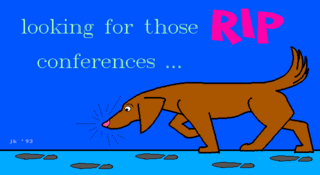
The Remote Imaging Protocol and its associated Remote Imaging Protocol Script language, RIPscrip, is a graphics language that provides a system for sending vector graphics over low-bandwidth links, notably modems. It was originally created by Jeff Reeder, Jim Bergman, and Mark Hayton of TeleGrafix Communications in Huntington Beach, California to enhance bulletin board systems and other applications.
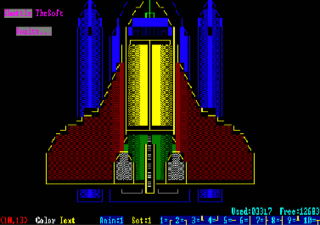
TheDraw is a text editor for MS-DOS to create ANSI and animations as well as ASCII art. The editor is especially useful to create or modify files in ANSI format and text documents, which use the graphical characters of the IBM ASCII code pages, because they are not supported by Microsoft Windows anymore. The first version of the editor was developed in 1986 by Ian E. Davis of TheSoft Programming Services. The last public version of the editor was version 4.63, which was released in October 1993.

Shift_JIS art is artwork created from characters in the Shift JIS character set, a superset of the ASCII encoding standard intended for Japanese usage. Shift_JIS art has become popular on web-based bulletin boards, notably 2channel, and has even made its way into mainstream media and commercial advertising in Japan.
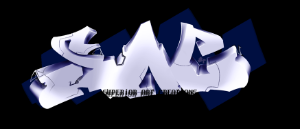
Superior Art Creations (SAC) is an underground artscene group which caters primarily to and is well known within the warez scene. SAC members have made, besides ANSI and ASCII art, VGA bitmap graphics, tracker music, and a variety of other works. SAC's character graphics have also been used in bottles and FTP servers.
International Network of Crackers (INC) was one of the premier cracking/releasing warez groups for the IBM PC during the late 1980s and early 1990s.
The Humble Guys (THG) were a cracking group for the IBM PC during the late 1980s founded by two friends known by the pseudonyms Candyman and Fabulous Furlough. The group was also noticed in the demoscene for some of their cracktros.

The Warez scene, often referred to as The Scene, is an underground network of piracy groups specialized in obtaining and illegally releasing digital media before their official release date. The Scene distributes all forms of digital media, including computer games, movies, TV shows, music, and pornography. This network is meant to be hidden from the public, with the files shared only with members of the community. However, as files became commonly leaked outside the community and their popularity grew, some individuals from The Scene began leaking files and uploading them to file-hosts, torrents and EDonkey Networks.

Creators of Intense Art, or Cia was an underground computer artscene group that primarily released ANSI, ASCII, and high resolution artwork from 1993 to 2001. Along with iCE and ACiD, Cia was one of the most active, and longest lasting groups on the artscene.
Myth was a warez group, focused on cracking and ripping PC games. Besides ripped games, the group also released trainers and cracked updates for games. Myth's slogan, "Myth, always ahead of the Class", was referring to the rival group Class that existed from 1997 to 2004.
Aces of ANSI Art was the first group of artists specifically organized for the purposes of creating and distributing ANSI art. The group was founded and operated by two BBS enthusiasts from California, "Zyphril" and "Chips Ahoy", from 1989 through 1991.











